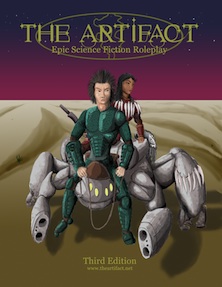Games have rules or at the very least a rule. RPGs tend toward having a lot of rules. Even rules lite games usually have as many pages of rules as a board game of standard complexity. Why is that? Is there any way around it? If you do get around it, what are the consequences?
First, a quick and dirty history of RPGs. Early RPGs were fairly light compared to what came in the 90’s. Then there was a move toward heavy books full of rules. In the next decade narrative driven games emerged that tend to have a smaller page count. Next came the Old School Revolution that focused its efforts on early RPGs that ran lite.
There’s a constant struggle to both expand what an RPG can govern and a wish to cut the discreet number of rules in the game. If the market of RPG customers have more free time, better visual acuity and the focus to support a large set of rules in their head, (usually late teen players) the size of RPGs get bigger. This has the effect of making it more difficult for young players (pre or early teens) to grasp the game and slows the rate that new players take up the hobby. It also is harder for working parents and older players who may have a hard time reading small type to adopt these large tomes.
Many games reduce their rule sets by having a central mechanic that is intended to govern (nearly) all interactions. This has gone a long way to make games easier to comprehend but the discrete rules that can spin off the core rules are also effectively endless so a game designer can still easily fill hundreds of pages with special case rules.
A game can reduce its rule set by applying what’s called “rule 0” or “the GM’s word is final”. Old School Revolution games rely in this heavily. The GM decides how rolls apply and often spot rule when a question arises. They make up a rule on the spot of how to resolve the situation. This can change from instance to instance but many gaming groups develop their own set of house rules, that if ever written down would bloat their lite game into something more comparable to a new school game from the 90’s.
A third way to reduce the set of rules is to not model a world but to give rules to govern the story being told. These “Narrative” games have a double edged sword to deal with in that they give lots of power to the players. This power if not carefully managed can lead to the game breaking down into something that is no longer a game because the rules do not sufficiently control play.
Large Rule Sets, Good For Players?
Early on in my gaming, I was a rules lawyer and I caused plenty of trouble as one. I wasn’t malicious, but I did cause arguments and I did use the rules to break the game when it served me. Back then, I probably couldn’t tell you why I rules lawyered. Now I understand things a bit better.
Rules that don’t change give power to the players. They allow the players to know how the game is played and helps them to tell the kind of story they want with their characters. Because of this, I’ve always viewed the written rules as my friend and any unwritten and malleable rule handed down from the GM as something I couldn’t rely on.
Think about a game of football where a player scores but the Referee can change the score based on how he felt about the effort? Would you know how to produce a strategy that would win the game? Possibly if that Ref was consistent you could. But what if he wasn’t consistent? What if he was mostly consistent but occasionally he would change his mind at the last moment? These are things I have seen GMs do.
Rules Help The GM
Another reason comprehensive rule sets can be good is that the GM has a heavy load to lift running a game. When there isn’t a rule to cover something, I’ve seen GMs default to “you can’t do that” even though most games tell the GM to make something up. When trying to handle all the other responsibilities of a game though, it can be hard for a GM to suddenly come up with how a novel solution should work. What’s worse is when the players want to replicate the effect of a novel solution and it threatens to unbalance the game.
Rules can also help build trust in a GM if they apply the rules evenly and the players see them doing so.
Pros vs Cons
On the one hand, a comprehensive rule set can help a game but on the other, it’s a barrier to new players, especially the young and the time strapped. There was a lot of wisdom in the “Basic” and “Advanced” rule sets of yesteryear. Get started with the basic and move onto the Advanced when you’re ready. Sometimes Quickstarts are a good approximation of the old Basic rule sets but they rarely are as flexible, usually only providing the GM an understanding of how to play a single adventure.


 The Free RPG Blog
The Free RPG Blog